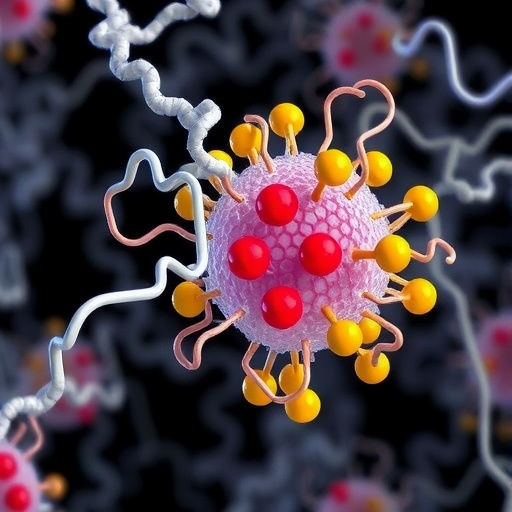In a groundbreaking study published in Nature, researchers have unveiled a comprehensive structural and functional map of human early endosome complexes, shedding new light on the dynamic interplay of ion transporters and their accessory proteins within this critical cellular compartment. This study notably identifies TMEM9 and TMEM9B as essential core subunits of the endosomal chloride/proton antiporters CLCN3, CLCN4, and CLCN5, reshaping our understanding of endosomal ion homeostasis and its implications in neuronal health and disease.
The essence of intracellular ion regulation lies in the finely tuned balance of luminal chloride (Cl⁻) and proton (H⁺) gradients within endosomes and lysosomes. High luminal chloride concentrations are known to activate several endolysosomal enzymes and are thought to serve as counterions that offset the proton gradient generated by vesicular ATPases (V-ATPases). The chloride-proton antiporters belonging to the CLCN family have emerged as critical players in this context, with distinct roles allocated to specific family members: CLCN3, CLCN4, and CLCN5 predominantly functioning within endosomes, and CLCN7 forming heterotetrameric complexes with OSTM1 in lysosomes.
The present work introduces EndoMAP.v1, an advanced molecular interaction mapping tool that revealed novel interactions between the CLCN family antiporters and the transmembrane proteins TMEM9 and TMEM9B. Crosslinking mass spectrometry and co-fractionation experiments demonstrated that TMEM9 and TMEM9B are enriched in early endosomes and physically associate with CLCN3, CLCN4, and CLCN5. These findings were robustly validated by Blue Native Mass Spectrometry (BN–MS) profiling, confirming that these proteins co-migrate in stable multi-protein complexes.
Computational modeling using advanced AlphaFold-based methods illuminated the architecture of these complexes. Specifically, AF-M and AlphaLink2 predicted strong interactions between CLCN3 or CLCN5 and dual transmembrane segments of TMEM9 or TMEM9B. Notably, the structural arrangement of TMEM9’s transmembrane domains exhibited a distinct conformation from that of OSTM1, the recognized lysosomal partner of CLCN7, hinting at specialized functional adaptations in endosomal complexes. The tetrameric assemblies gleaned from the predictions consistently fulfilled crosslinking distance restraints and preserved the canonical antiporter dimer interface.
Extensive live-cell imaging studies reinforced the physical and spatial association of TMEM9 with CLCN3. In SUM159 breast cancer cells, co-expression of TMEM9–GFP and mCherry-tagged CLCN3 revealed considerable co-localization within vesicular structures, as quantified by Mander’s coefficients hovering around 0.7. This co-localization was predominantly observed in EEA1-positive early endosomal compartments rather than in LAMP1-positive late endosomes or lysosomes, pinpointing TMEM9’s function to early endosomal ion homeostasis.
Further, TMEM9’s dynamic behavior was correlated with the formation of swollen endosomes induced by CLCN3 overexpression. This morphological change likely reflects altered ion flux and membrane trafficking events necessitated by antiporter activity and indicates a potential regulatory role for TMEM9 in endosomal maturation or trafficking dynamics.
Reciprocal co-immunoprecipitation experiments in HEK293 cells substantiated these interactions at the molecular level, with Flag-tagged CLCN3 and CLCN5 showing direct associations with HA-tagged TMEM9 and TMEM9B. This biochemical evidence corroborated the previous proteomic and imaging data, collectively supporting the model in which TMEM9 family members function as integral components of CLCN antiporter complexes.
To explore the physiological relevance of TMEM9 in neuronal cells, the authors engineered TMEM9 knockout human embryonic stem cells and differentiated them into induced neurons (iNeurons). Through tandem mass tag (TMT) multiplexed immunoprecipitation-mass spectrometry (IP–MS), the study revealed that multiple CLCN paralogs (CLCN3, CLCN4, CLCN5) and TMEM9B co-purify specifically with TMEM9, underscoring the specificity and conservation of these interactions in neuronal endosomes.
Crucially, quantitative proteomic analyses of early endosome immunoprecipitates from wild-type, TMEM9 knockout, and TMEM9/TMEM9B double knockout neurons uncovered significant reductions in the abundance of the CLCN antiporters when TMEM9 family members were absent. This finding implicates TMEM9 and TMEM9B not merely as structural subunits but as vital factors governing the stability, assembly, or trafficking of the endosomal CLCN complexes, with clear distinctions from lysosomal counterparts.
These discoveries carry profound implications for neurobiology, as CLCN3 variants have been previously implicated in intellectual disabilities and animal models deficient in CLCN3 exhibit neurodegeneration. The elucidation of TMEM9 and TMEM9B as core subunits opens new avenues for understanding the molecular pathology of endosomal ion transport defects in neurological disorders.
Structurally, the divergence in transmembrane arrangements and luminal domain conformations between the TMEM9 heterotetramers and the OSTM1-containing lysosomal complexes suggests specialized functional roles potentially tailored to the distinct ionic milieus and trafficking pathways of early endosomes. The β-β-α-α-α-β folds contributed by TMEM9 may serve as a luminal ‘cap’, akin to but distinct from the helical cap of OSTM1, possibly influencing antiporter gating or regulatory interactions.
In sum, this comprehensive study redefines TMEM9 and TMEM9B as indispensable partners of endosomal CLC chloride/proton antiporters. By revealing these proteins as integral to the structural integrity and function of the complexes, it lays the foundation for future research aimed at deciphering the mechanisms of early endosomal ion homeostasis and its perturbation in disease states.
The multidisciplinary approach combining proteomics, structural biology, live-cell imaging, and neurogenetics underscores the power of integrative strategies to unravel complex membrane protein assemblies. These insights will undoubtedly spur the design of targeted therapeutics aimed at restoring ion transport in defective endosomal and lysosomal systems implicated in a range of neurodevelopmental and neurodegenerative disorders.
Subject of Research:
Human early endosomal chloride/proton antiporter complexes and their core subunits TMEM9 and TMEM9B.
Article Title:
EndoMAP.v1 charts the structural landscape of human early endosome complexes.
Article References:
Gonzalez-Lozano, M.A., Schmid, E.W., Miguel Whelan, E., et al. EndoMAP.v1 charts the structural landscape of human early endosome complexes. Nature (2025). https://doi.org/10.1038/s41586-025-09059-y
Image Credits:
AI Generated




